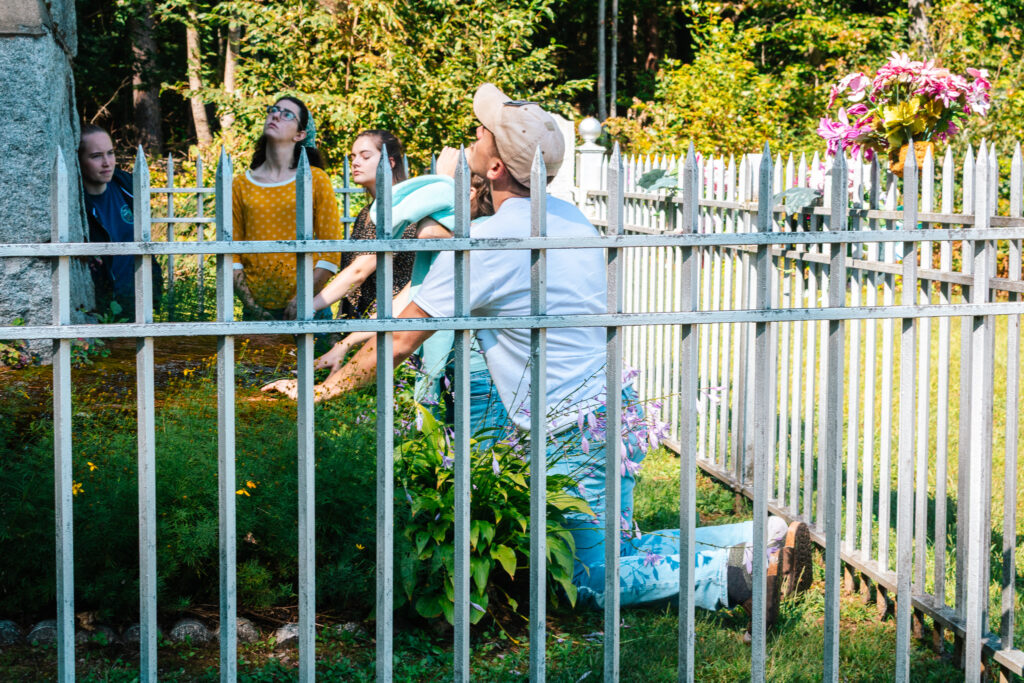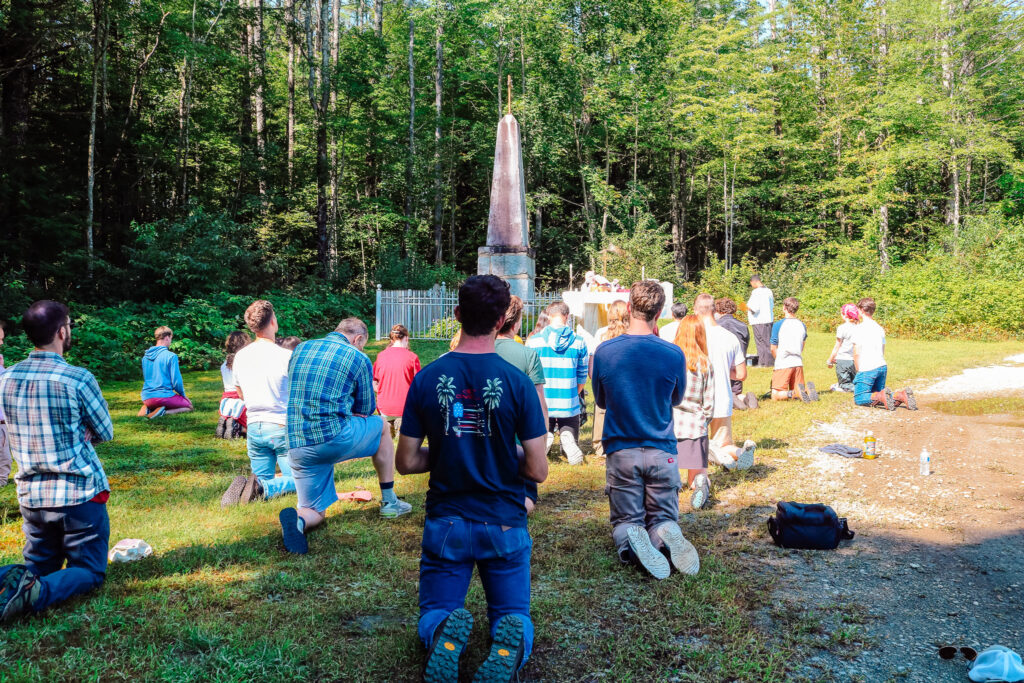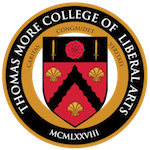By Michael Dominic Taylor, PhD, Teaching Fellow and Dean of Students
The following was published in the Fall-Winter 2024 issue of TMC’s Communitas newsletter. It is reprinted here in anticipation of returning to the land of Fr. Rale once again for our 2025 New Student Orientation.
Every student of Thomas More College knows that the campus falls within the territory once occupied by “the People of the Land of the Dawn,” the Abenaki. Differing in language and customs from the Iroquois (located in present-day New York and around the Great Lakes), the Abenaki were an Algonquin people, their lands spanning from northern Massachusetts to Vermont, New Hampshire, Maine, Nova Scotia—all the way to parts of Newfoundland. When the French first laid claim to the coast of present-day Maine, some of the first missionaries were the Jesuits, Fr. Pierre Biard and Fr. Énemond Massé. Arriving in 1613, they had set out for present-day Bangor but were blown off course and decided to settle on what is known as Fernald Point on “Mount Desert Island”—named so by another Frenchman, Samuel de Champlain, nine years earlier but called “Pemetiq” by the natives. Fr. Biard and Fr. Massé called the mission Saint-Sauveur. Nothing remains of the mission except its name, which graces one of the mountains of what is now Acadia National Park. Fernald Point is mostly private land today, but maps still retain a mysterious landmark: “Jesuit Spring.”
When Fr. Biard, Fr. Massé, and company arrived to the spot, they were encouraged to stay and build their mission there by the natives they encountered, one of whom had experienced the benevolence of the “Black Robes” two years prior when they visited the area of Castine. Knowing the goodness of the Black Robes, the natives were naturally overjoyed. So when another European ship arrived in the area a few months later, one innocent Abenaki assumed that they were friends of the Black Robes and led them to the settlement. Tragedy ensued.
The fishing vessel, which had set out from the English settlement in Jamestown, transformed into a warship and opened fire on the French at first sight. Among the company was an industrious and faithful Jesuit brother named Gilbert Du Thet who was killed in the onslaught, pouring his blood and what remained of his life into the land of the Abenaki. The captain of the English ship was none other than Samuel Argall, the deputy governor of Virginia who had, just months before, kidnapped Pocahontas. Under orders from England, he would also destroy Sainte-Croix (on the Canadian border) and Port-Royal, the heart of Acadia in Nova Scotia. The settlements were destroyed and the natives dispersed. Fr. Biard and Fr. Massé were taken prisoner along with a dozen others, but they would ultimately survive, miraculously making their way back to France.
Reflecting on the ordeal years later in The Jesuit Relations, Fr. Biard would respond to the question “Was it worth it?” in this way: “For he that planteth is nothing, nor he that watereth; but he who giveth the increase (1 Cor 3:7); and this increase is first made under the ground, and out of the sight of men.”

Brother Gilbert Du Thet’s remains were buried in the ashes of Saint-Sauveur, and yet no trace of his grave remains today. Perhaps, however, we could ask for no better grave marker for the first Catholic martyr of these lands than that of “Jesuit Spring.” Over the century that followed, the Jesuits would continue to plant the seeds of faith across the land and irrigate them with their own blood. This faithful Jesuit spring would flow through the land, down its rivers, and into the sea of eternity as the Black Robes gave their lives for the souls of that first people to dwell among the “murmuring pines and the hemlocks” (Longfellow, Evangeline).
Fr. Sébastien Rale would join the glorious procession of Jesuit missionary-martyrs in 1724. However, unlike his brethren who died at the hands of the Indians they had been sent to serve, it would be at the hands of the English, like Brother Du Thet one-hundred and eleven years earlier. Over thirty years of service in the village of Norridgewock, alongside the Kennebec River, Fr. Rale would see the Abenaki people become a fully Catholic nation and the northernmost lands of New England, Catholic lands. He built a church and two chapels in Norridgewock, had thirty altar servers chanting the Mass in Latin, and tended to his flock tirelessly. But after the Treaty of Utrecht in 1713, by which France ceded these lands to England, the English colonists would lay claim to everything north of Massachusetts. A £100 bounty—equivalent to over $30,000 today—was put on Fr. Rale’s head, as he was correctly identified as the spiritual leader of the Abenaki, giving them courage and reassurance that their desire to live in the land of their fathers was meet and just.
In the skirmishes that followed the treaty, one of the Abenaki chapels was burned down. The governor of Boston hoped to take advantage of the situation by offering to rebuild it. The following was recounted by Fr. Rale to his brother in a letter:
The Governor received them with great demonstrations of friendship, and showed them every kind of attention. “I myself wish to rebuild your Church,” he said to them, “and I will treat you better than your French Governor has done,—he whom you call your father. It is his duty to rebuild it, since it was he who in a certain way destroyed it, by inducing you to strike me,—for, on my part, I defend myself as I am able; whereas he, after having used you for his defense, abandons you . . . But, as it is not reasonable that I, who am English, should build a Church without putting in it an English Minister to take care of it, and to teach you prayer, I will give you one with whom you will be content, and you shall send back to Quebec the French Minister who is in your Village.”
“Thy words astonish me,” responded the Deputy of the Savages, “and I wonder at the proposition that thou makest me. When thou camest here thou sawest me a long time before the French Governors did; neither those who preceded thee, nor thy Ministers, ever spoke to me of prayer or of the Great Spirit. They saw my furs, my beaver and elk-skins, and of those alone did they think; it was those that they sought with eagerness; I was not able to furnish them enough, and, when I brought many, then I was their great friend, and that was all. On the contrary, my canoe having one day been misguided, I lost my way and wandered at random for a long time, until at last I landed near Quebec, at a large village of the Algonkins, where the black Robes were teaching. I had hardly landed when a black Robe came to see me. I was loaded with furs, but the French black Robe did not deign even to look at them; he spoke to me first of the Great Spirit, of Paradise, of Hell, and of Prayer, which is the only way of reaching Heaven. I listened to him with pleasure, and I enjoyed his talks so much that I remained a long time in that Village for the sake of hearing him. In short, the Prayer pleased me, and I besought him to instruct me; I asked for Baptism, and received it. Afterward I returned to my own Country and I recounted what had happened to me; my people envied my happiness, and wished to participate in it; accordingly they set out to go to the black Robe, to ask him for Baptism. It was thus that the Frenchman treated me. If, when thou didst first see me, thou hadst spoken to me of Prayer, I would have had the misfortune to pray as thou dost; for I was not capable of distinguishing whether or not thy prayer were right. Therefore I tell thee that I hold to the prayer of the Frenchman; I accept it, and I shall keep it until the world shall burn and come to an end. Accordingly keep thy Workmen, thy money, and thy Minister; I shall speak of them no more, but I shall ask the French Governor, my father, to send me some” (Letter of Fr. Rale, October 12, 1723).
After numerous attempts, on August 23, 1724, Captains Johnson Harmon, Jeremiah Moulton, and Richard Moulton led a group of two hundred New England Colonials to Norridgewock and finally succeeded in their aim. At sixty-seven years old, Fr. Sébastien Rale was dead. After thirty-five years in this foreign land, he returned to his Father’s house alongside Chiefs Bomazeen, Welakwansit, Wissememet, Job, Carabasett, and scores of other Abenaki Indians. The village of Norridgewock was burned to the ground and the Abenaki were systematically subdued or displaced from the region.

As the students of Thomas More College are well aware, the land on which the College sits belonged to the Blanchard family. Though holding the deed to the land for many years, they did not hazard to take possession of it until 1726, two years after Fr. Rale’s death and the submission of the Abenaki. Anyone who has visited will have seen that the year “1726” is painted on the shed next to the barn that now holds the Thomas More College Chapel.
Today, through the mysterious channels of Providence, God’s grace—born witness to by the blood of Fr. Rale and the blood of St. Thomas More—has inspired the rebirth of a Catholic community that has stood on these lands for nearly a half-century. Thus, we saw it fit to honor the 300th anniversary of Fr. Rale’s sacrifice by making a pilgrimage to his adoptive Abenaki lands and his tomb. On August 25, 2024, after nearly a year of planning, the new freshman class and transfer students, accompanied by a dozen returning students and another half-dozen faculty and staff, set out for Maine in honor of Fr. Rale’s sacrifice and the faith he poured into the land with his life—and his death.
For further reading:
TMC Students Traverse Over Sixty Miles in Pilgrimage for Restoration
